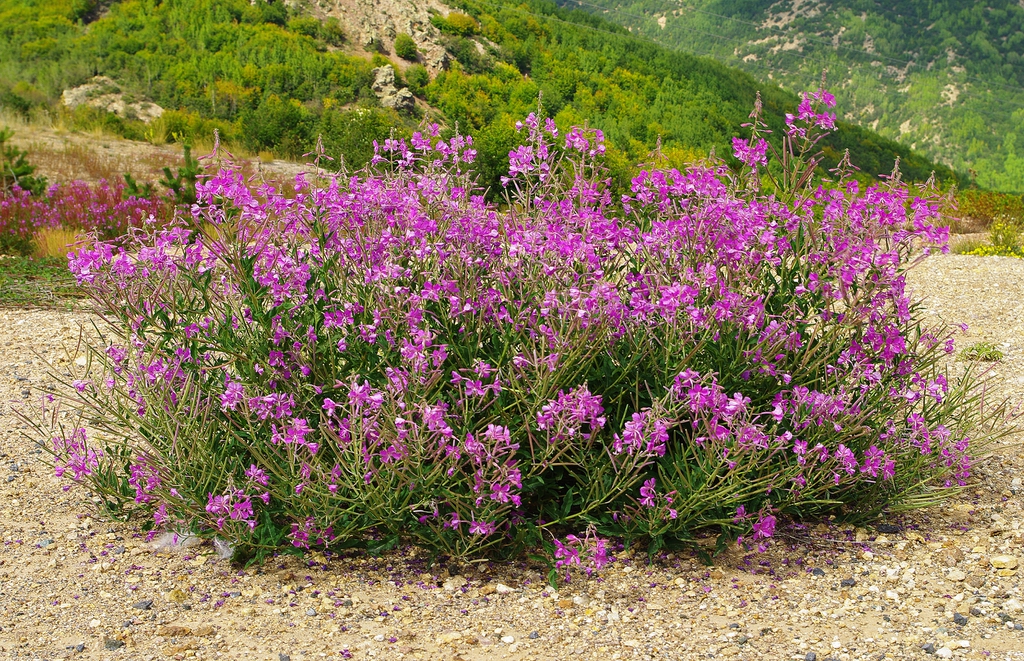Great Willow Herb Epilobium angustifolium
Other Common Name(s):
Previously known as:
- Chamerion angustifolium
- Epilobium angustifolium
- Phonetic Spelling
- ep-ih-LOW-bee-um an-gus-tee-FOH-lee-um
- Description
-
Formerly known as Epilobium angustifolium, it was moved to the genus Chamerion due to its differences from the Epilobium genus. The Greek word chamai translates to dwarf, while nerion means oleander, referring to the foliage looking like the leaf of an oleander. The Latin words angustus (narrow) and folium (leaf) again reference the foliage, which is a narrow leaf.
Fireweed is a rhizomatous perennial wildflower that is easy to grow in full sun to partial shade, high organic matter, and well-drained soil. It can struggle in our hot southern summers, requiring afternoon shade and moist soils and does best in the mountain region of the state. It is found in a variety of areas including roadsides, clearings, ravines, fields, pastures, along streams and open woods. The common name comes from its propensity to be the first plant to appear after fires. It will spread by both seeds and rhizomes, creating large patches that may be classified as weedy.
Plant in informal areas of the landscape including meadows or woodland gardens, in borders, or massed in rock or cottage gardens. To encourage more blooming remove spent flowers before they go to seed. Propagation can be accomplished through division in the spring or fall.
As well as producing edible stems, flowers, and leaves, this plant has many other uses. Fibers obtained from the stems can be used to make cords and ropes. The seed hairs that are cotton like are used as stuffing or as tinder for a fire. It is also a host plant for the Cloudless sulpher butterfly (Phoebis sennae), as well as the Fireweed clearwing (Albuna pyramidalis), Bedstraw hawkmoth (Hyles gallii), and the Nessus sphinx (Amphion floridensis) moths.
Insects. Diseases, and Other Plant Problems: Snails and slugs are occasional visitors. Powdery mildew, rust, and leaf spot are occasional problems. The wind-dispersed seeds can make fireweed weedy and aggressive.
- See this plant in the following landscape:
- Cultivars / Varieties:
-
- Tags:


































































- Cultivars / Varieties:
-
- Tags:
-
-
Attributes:
- Genus:
- Epilobium
- Species:
- angustifolium
- Family:
- Onagraceae
- Uses (Ethnobotany):
- Older stems have been used to make twine and fishnets
- Life Cycle:
- Perennial
- Recommended Propagation Strategy:
- Division
- Seed
- Country Or Region Of Origin:
- Temperate northern hemisphere
- Distribution:
- AK , MT , WA , WY Canada: BC , NB , NL , NS , ON , PE , QC , SK , YT
- Wildlife Value:
- Honeybees are attracted to the flowers and the nectar from fireweed makes delicious honey. Serves as a host plant for several species of lepidoptera, which includes butterflies and moths. Attractive to wildlife.
- Play Value:
- Attractive Flowers
- Attracts Pollinators
- Buffer
- Easy to Grow
- Screening
- Wildlife Food Source
- Wildlife Larval Host
- Edibility:
- Young shoot tips, flower stalks and leaves can be cooked and eaten. a tea with a sweet taste can be made from its dried leaves.
- Dimensions:
- Height: 2 ft. 0 in. - 5 ft. 0 in.
- Width: 1 ft. 0 in. - 3 ft. 0 in.
-
-
Whole Plant Traits:
- Plant Type:
- Herbaceous Perennial
- Wildflower
- Woody Plant Leaf Characteristics:
- Deciduous
- Habit/Form:
- Erect
- Growth Rate:
- Rapid
- Maintenance:
- Medium
- Texture:
- Medium
-
-
Cultural Conditions:
- Light:
- Full sun (6 or more hours of direct sunlight a day)
- Partial Shade (Direct sunlight only part of the day, 2-6 hours)
- Soil Texture:
- Clay
- High Organic Matter
- Loam (Silt)
- Sand
- Shallow Rocky
- Soil pH:
- Alkaline (>8.0)
- Neutral (6.0-8.0)
- Soil Drainage:
- Good Drainage
- Moist
- Available Space To Plant:
- 12 inches-3 feet
- 3 feet-6 feet
- NC Region:
- Mountains
- USDA Plant Hardiness Zone:
- 2a, 2b, 3a, 3b, 4a, 4b, 5a, 5b, 6a, 7a, 7b
-
-
Fruit:
- Fruit Color:
- Brown/Copper
- Red/Burgundy
- Display/Harvest Time:
- Fall
- Summer
- Fruit Type:
- Capsule
- Fruit Description:
- The reddish-brown seed pod contains numerous seeds with a tuft of silky hairs at one end. Seeds are wind-dispersed.
-
-
Flowers:
- Flower Color:
- Pink
- Purple/Lavender
- Flower Inflorescence:
- Raceme
- Flower Value To Gardener:
- Showy
- Flower Bloom Time:
- Fall
- Summer
- Flower Shape:
- Saucer
- Flower Petals:
- 4-5 petals/rays
- Flower Size:
- 1-3 inches
- Flower Description:
- 1-1.5 in. deep pink to magenta-purple saucer-shaped flowers on an elongated, slender, drooping inflorescence; four roundish petals. Blooms in summer from the bottom to the top of the stem in terminal racemes.
-
-
Leaves:
- Woody Plant Leaf Characteristics:
- Deciduous
- Leaf Color:
- Green
- Leaf Value To Gardener:
- Edible
- Leaf Type:
- Simple
- Leaf Arrangement:
- Alternate
- Leaf Shape:
- Lanceolate
- Linear
- Leaf Margin:
- Entire
- Hairs Present:
- No
- Leaf Length:
- 3-6 inches
- Leaf Width:
- < 1 inch
- Leaf Description:
- 2"-8" in. long 3/4" wide willow-like lanceolate or linear leaves with pinnate veins. They are arranged alternately and spiral up the stem.
-
-
Stem:
- Stem Color:
- Green
- Red/Burgundy
- Stem Is Aromatic:
- No
- Stem Surface:
- Smooth (glabrous)
- Stem Description:
- Reddish-green, unbranched, stiff, upright stems.
-
-
Landscape:
- Landscape Location:
- Naturalized Area
- Woodland
- Landscape Theme:
- Butterfly Garden
- Cottage Garden
- Edible Garden
- Pollinator Garden
- Rock Garden
- Design Feature:
- Border
- Mass Planting
- Small groups
- Attracts:
- Bees
- Butterflies
- Moths
- Pollinators
- Resistance To Challenges:
- Fire
- Problems:
- Weedy








